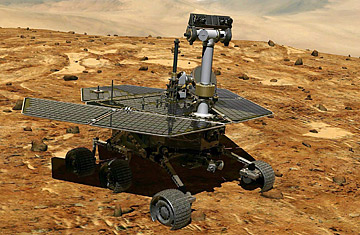
A computer-generated image of the Spirit rover
There aren't a lot of machines that operate 20 times longer than they were supposed to. There aren't a lot of scientists doing 20 times more research than they intended to. There aren't a lot of explorers covering 20 times more ground than they were supposed to be able to.
But then again, there aren't a lot of things like NASA's Spirit and Opportunity Mars rovers, the robotic ships that landed on the Red Planet five years ago this month with an expected lifespan of 90 days and yet have chugged along ever since — surviving paralyzing cold, blinding dust and long periods without sun, all of which occasionally left them silent and still, but only until conditions improved and they shook off the dust, stirred to life and puttered off to do more work. So far, Spirit and Opportunity have beamed home a quarter of a million images and 36 gigabytes of data and revealed more about Martian history than any other spacecraft in a half-century of space travel. And by all indications, they could be keeping it up for a long time to come.
The dune buggy–size Spirit and Opportunity are the third in NASA's family of Mars rovers, descendants of the 2-ft.-long Sojourner craft, which arrived on Mars in the summer of 1997. Like its bigger siblings, Sojourner came with only a very brief factory warranty — just 30 days in its case — and like its bigger siblings, easily exceeded it, operating for five months before finally surrendering to the Martian elements. It's rarely a good idea to take NASA's estimates of the lifespan of its ships too literally. The agency tends to lowball these calls, making it more likely that the machines will perform better than advertised — and, not incidentally, that taxpayers will feel as though they're getting their money's worth. Still, when flight controllers on the Spirit and Opportunity teams began reporting for work in January 2004, few thought they'd be doing the same jobs in January 2009. (See pictures of the rovers' five-year history.)
The two rovers were launched atop separate boosters. Spirit left Earth on June 10, 2003, and Opportunity followed on July 7, taking advantage of the biannual close approach Mars and Earth make as they orbit the sun. On solar system scales, a close approach is still a goodly distance — 35 million miles in 2003 — which means that the rovers needed seven months to get where they were going. Spirit landed first, bouncing down in a swaddle of air bags in Mars' Gusev Crater. Opportunity followed three weeks later, landing on the other side of the planet in what is now known as Eagle Crater.
The two spots were chosen for a very good reason. Despite the caps of ice in Mars' polar regions and the deposits of ice thought to lie beneath the soil, the planet is a desiccated place. But that doesn't mean Mars wasn't once wet, and its topography — scarred with what appear to be ancient river channels and dry seabed — suggests that the planet once fairly sloshed with water. If you want to find signs of ancient life, the key is to follow that water — or at least the places it used to be.
Spirit and Opportunity did just that, aiming for vast basins that have the look of land that was once submerged. Spirit soon uncovered evidence of salts in the soil, a substance that would have been abundant in Martian seas, just as it is in Earth's. Opportunity discovered deposits of BB-sized pellets — which NASA nicknamed blueberries — that are rich in hematite, a mineral that forms only in watery environments. And by pure serendipity, in 2007 a balky wheel on Spirit dug a shallow trench in the ground, revealing the presence of white silica, another indicator of water. So far, neither rover has uncovered hard evidence of life, but by no means have they ruled it out either.
Spirit's busted wheel is not the only lame limb on the now aging rovers. Opportunity's robotic arm — which carries many of its exploration tools, including its rock drill — has what amounts to an arthritic elbow. This makes it impossible for the arm to retract fully and requires the rover to toddle along with a sort of perpetual salute. Spirit itself has been reduced to driving backwards, dragging its broken wheel in the soil as it moves along.
Still, move along both rovers do. Spirit's next destinations are the comparatively nearby Goddard Crater and an outcropping of what might be volcanic material. Opportunity has just embarked on a long march toward Endeavour Crater, a seven-mile journey that — with the rover's slow speed and frequent stops and starts — will take two years to complete.
By the time Opportunity arrives, Spirit may be gone. The caprice of the Martian winds has done a better job of clearing Opportunity's solar panels than Spirit's, and project manager John Callas says that although both rovers survived the past Martian winter, in Spirit's case, it was a "squeaker." The winter that will come later in 2009 could easily be its last. Of course, the same was true of the winters that came and went from 2004 to 2008. Both machines clearly inherited long life from their Sojourner granddaddy, and both seem equally determined to make the most of it.
